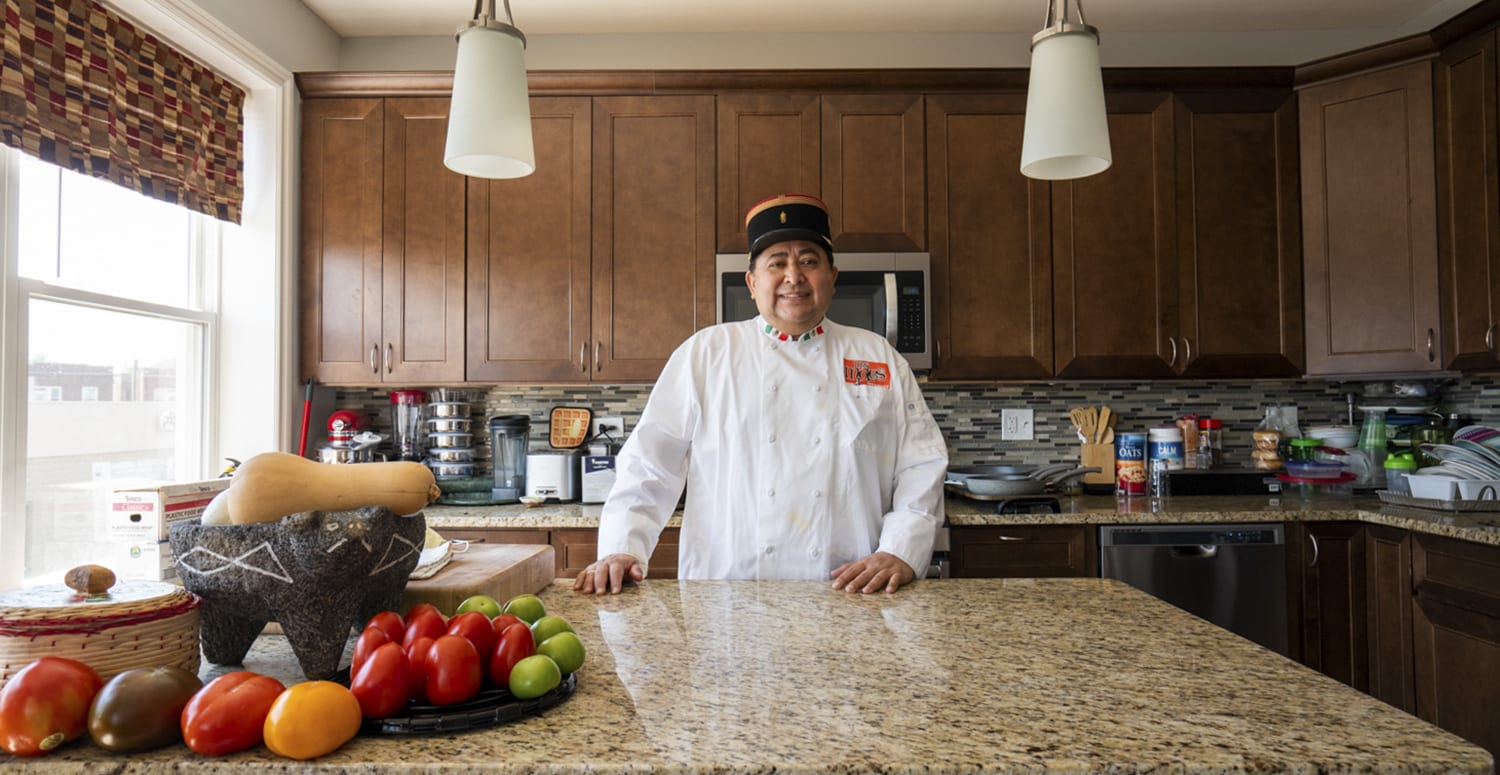 Fotografía de Camilla Forte/Borderless Magazine
Fotografía de Camilla Forte/Borderless MagazineEl legendario chef mexicano Geno Bahena se enfrenta al COVID de larga duración, la escasez de personal y las tensiones financieras en su restaurante de topos.
No te pierdas ni una noticia. Suscríbase a nuestro boletín de los jueves para conocer lo último sobre las comunidades de inmigrantes de Chicago.
"Yo ayudaba añadiendo los chiles, uno a uno", explica Bahena. "Añadíamos cada uno de los 32 ingredientes en pequeñas cacerolas. Imagínate, 32 cacerolas".
Bahena aprendió los secretos de uno de los platos más famosos de México cuando su abuela le hacía medir el dulzor de cada ingrediente, desde el chile pasilla ahumado hasta las pasas.
"Me decía para qué servía cada ingrediente. Añadíamos pan y tortillas para que la comida fuera más abundante, chocolate para darle más sabor", cuenta Bahena.
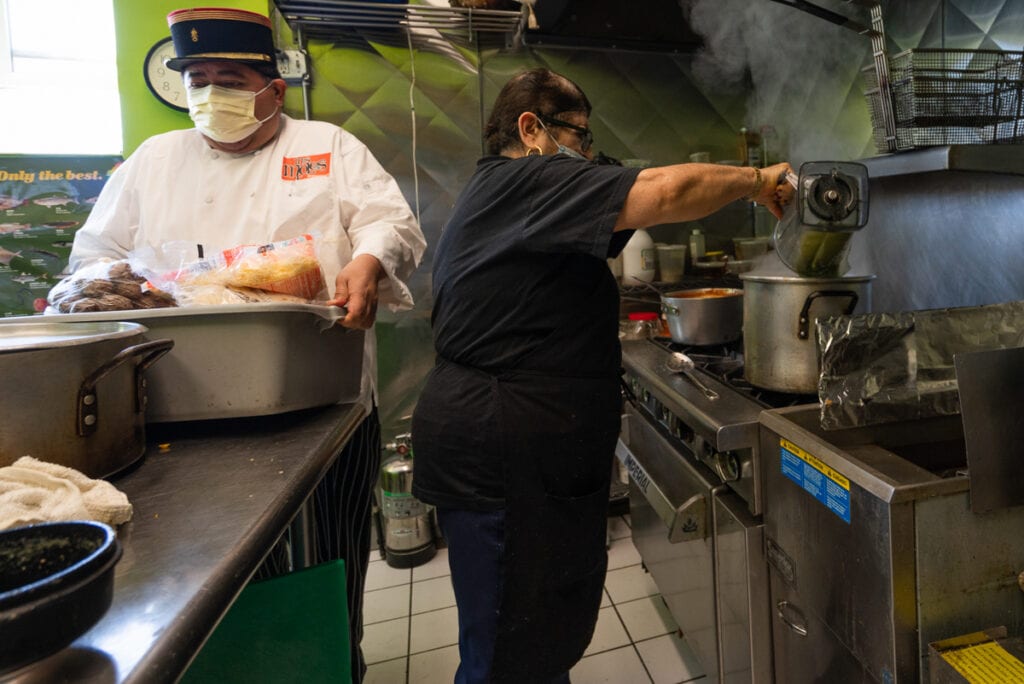
Cuatro décadas después, Bahena es un experto en mole y un chef de renombre que ha cocinado para personalidades como el ex presidente George W. Bush y el ex presidente mexicano Vicente Fox. Ha abierto, y más tarde cerrado, restaurantes propios en Chicago, como Ixcapuzalco, Chilpancingo, Geno's Bar & Grill y Mi Sueño Su Realidad.
Bahena es ahora socio y chef ejecutivo del restaurante Mis Moles, en el barrio Irving Park de Chicago. El negocio abrió sus puertas durante la pandemia y, como muchos otros en todo el país, ha tenido que hacer frente a la crisis. cambios en las restricciones gubernamentales y una economía lenta. A pesar de los anuncios en Internet y en el exterior del restaurante, Mis Moles sigue sin tener personal suficiente.
El propio Bahena también ha tenido problemas. Contrajo COVID-19 en noviembre y estuvo hospitalizado casi tres semanas. A día de hoy, sufre de falta de aliento y fatiga mientras cocina y sube y baja la comida por las escaleras hasta el congelador del restaurante. Pero tiene que trabajar: Actualmente es el único cocinero a tiempo completo del restaurante. Entre la escasez de personal, los problemas financieros y el largo viaje de Bahena a COVID, el futuro de Mis Moles está en peligro.
"Elegancia desde el corazón de México"
La fascinación de Bahena por la cocina empezó en los fogones con su abuela, pero se obsesionó con ella después de preparar su primera comida durante una discusión con su madre.
"Quería cocinar algo, pero ya estaba lleno", dijo. "Había comido mangos y ciruelas, pero quería hacer algo y cocinarlo yo. Mi madre me dijo: 'No, siéntate a la mesa y come lo que te sirva'". Haciéndose el intermediario, el padre de Bahena le permitió cocinar siempre y cuando se terminara hasta el último bocado. Bahena hizo chilaquiles y se comió hasta el último bocado.
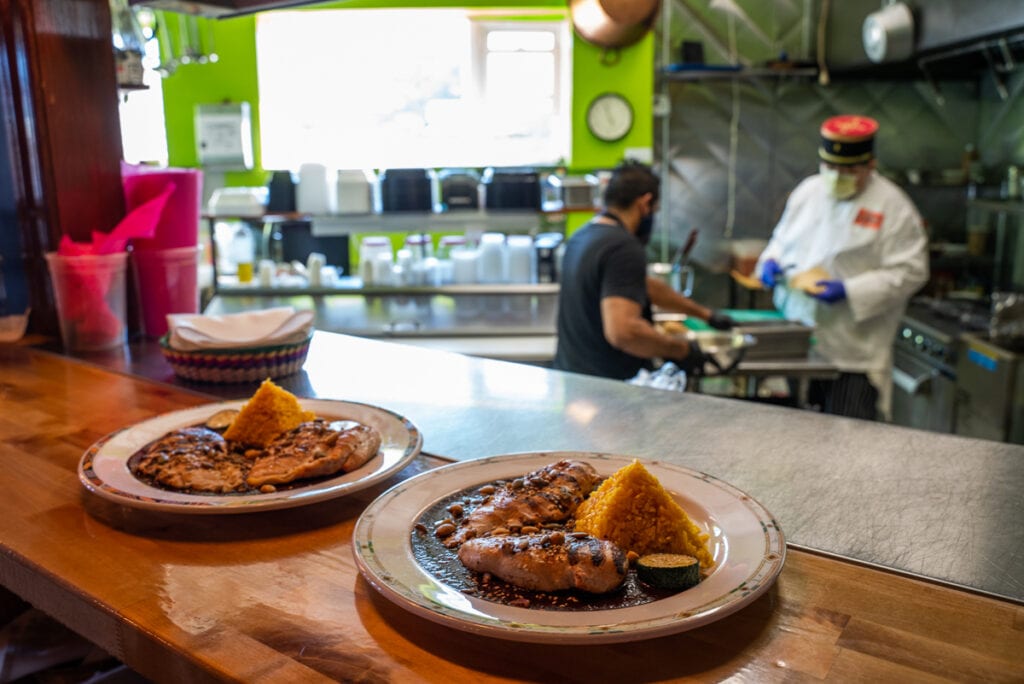
En 1982, Bahena se fue de México a Chicago, donde conocía a un par de personas que habían trabajado en el rancho de su padre en Tepatulco. "Me vine cuando era adolescente porque tenía el corazón roto", dijo sobre la ruptura con su primera novia. "Pensé que era el fin del mundo".
Unos meses después de llegar a Chicago, Bahena intentó matricularse en el programa culinario del St. Augustine College, pero le pusieron en lista de espera y tuvo que demostrar que era mejor cocinero que los demás futuros estudiantes. Fiel a su costumbre, Bahena preparó pollo con mole para el examen de ingreso. Y lo consiguió.
En la universidad, Bahena perfeccionó las habilidades que había desarrollado junto a su abuela, y mucho más. Tras graduarse, puso en marcha un negocio de catering cuyo nombre, A Taste of Elegance from the Heart of Mexico, englobaba el estilo de cocina que le convertiría en un éxito nacional. Al mismo tiempo, Bahena se convirtió en el chef jefe de Rick Bayless en sus restaurantes Frontera Grill y Topolobampo. Posteriormente, Bahena abrió varios restaurantes, que fue vendiendo poco a poco para dar paso a nuevas ideas y negocios.
En 2020, Bahena trabajaba en Massachusetts cuando recibió un mensaje de Branko Podrumedzic que le traería de vuelta al Medio Oeste.
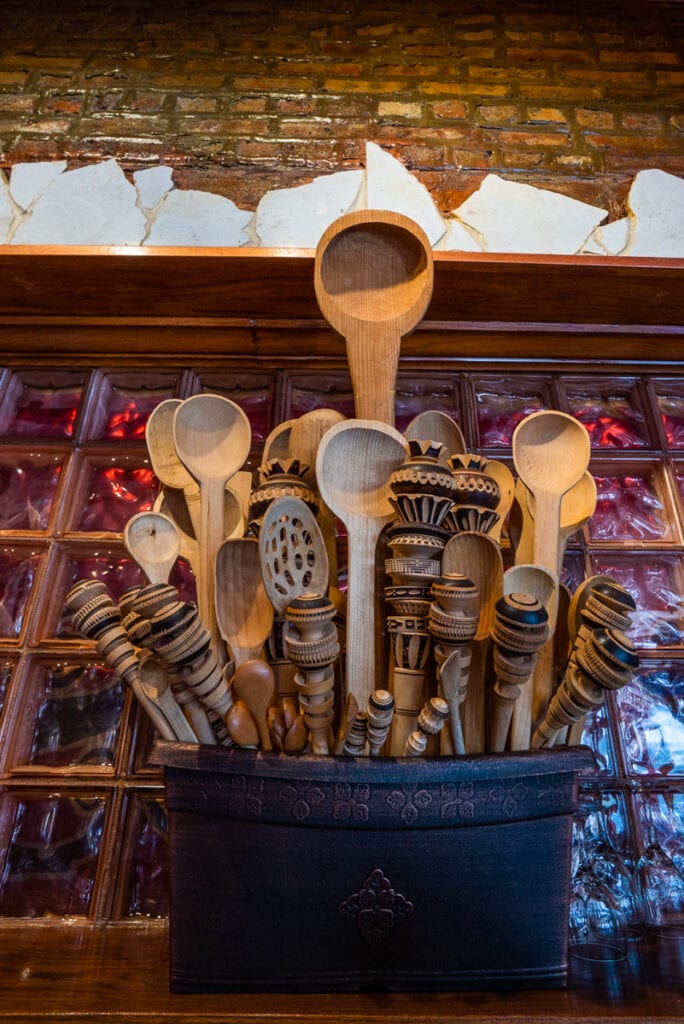
Podrumedzic, inmigrante serbio en Chicago, estaba a punto de cerrar Little Bucharest Bistro, su restaurante de Europa del Este de 50 años que pasó su última década en Irving Park. Estaba listo para transformarlo en un nuevo restaurante, y necesitaba un socio.
Podrumedzic se puso en contacto con Bahena para ofrecerle dirigir el restaurante. "Quería jubilarme, y entonces encontramos a Geno, y vi que es uno de los mejores cocineros de mole", dijo.
Bahena aceptó la idea. Estaba dispuesto a abrir otro restaurante y quería estar más cerca de su madre, que se había trasladado a Chicago en 1992.
Bahena decidió que el punto central del restaurante sería el plato que aprendió a cocinar por primera vez junto a su abuela décadas atrás. El chef, que dice haber viajado a todos los municipios de México y probado los moles de cada estado, reservó cuatro de sus moles favoritos para la idea del menú de Mis Moles: negro, rojo, verde y manchamanteles. Bahena también añadió especialidades regionales como enchiladas, pato en salsa cremosa de chipotle y cochinita pibil, un plato de cerdo asado a fuego lento.
Además de escribir el menú, Bahena rediseñó el interior de Little Bucharest Bistro para adaptarlo a la cocina de Mis Moles. Gastó 150.000 euros en pintar las paredes de azul y rosa, comprar obras de arte con escenas de mercados mexicanos y cambiar el suelo.
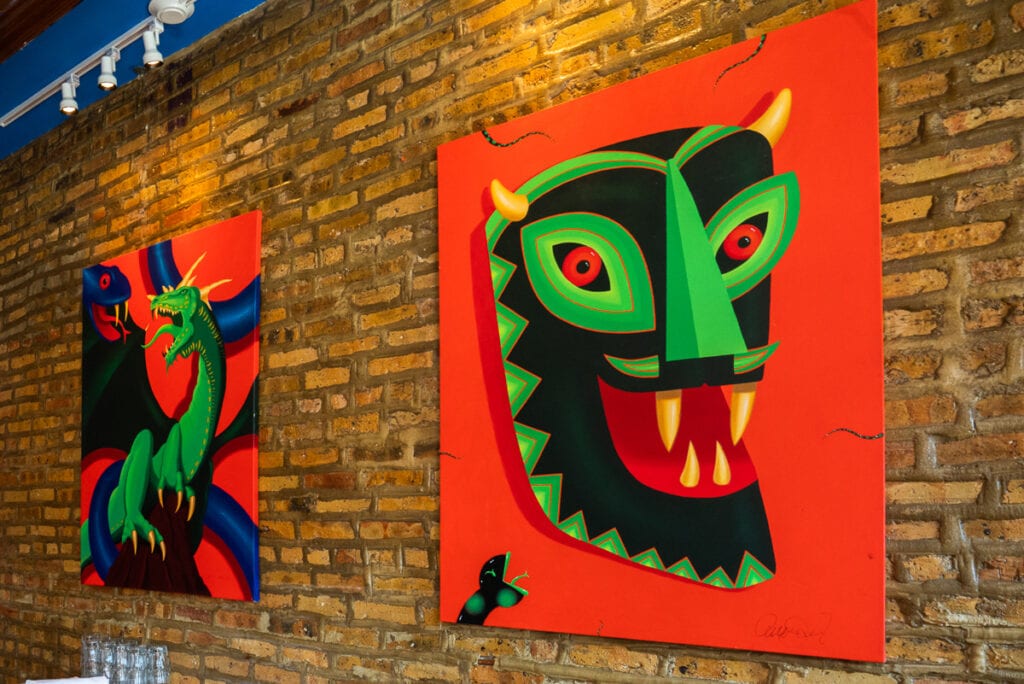
Bahena también se mudó a un apartamento encima de Mis Moles, donde planificó los platos para la apertura del restaurante en junio de 2020.
Mientras tanto, el virus COVID-19 se extendía por todo Estados Unidos. El número de nuevos casos notificados rondaba los 50.000 casos diarios, según los Centros para el Control y la Prevención de Enfermedadesy los restaurantes estaban a capacidad parcial. Muchos cerraron sus puertas para siempre.
"No tenemos el poder"
A pesar de lo difícil que puede resultar abrir un restaurante en medio de una pandemia, a Mis Moles le fue relativamente bien tras su inauguración el pasado mes de junio. Abría seis días a la semana para cenar en el patio, que a menudo estaba lleno. Bahena dirigía la cocina, que al principio contaba con otros seis cocineros, entre ellos su madre, Clementina Flores, que también es chef. Hacía todos los moles desde cero y supervisaba muchas de las operaciones del restaurante y a sus 13 empleados. Pocas personas en Yelp han dado a Mis Moles menos de cinco estrellas.
Cuando el COVID-19 se disparó en otoño, el restaurante pasó a ofrecer solo comida para llevar. Por primera vez en su larga carrera, Bahena puso su restaurante en las plataformas de reparto DoorDash y Grubhub. Bahena bromeó diciendo que la comida era demasiado elegante para pedirla a domicilio y se lamentó de las elevadas tarifas de las plataformas, pero no vio otras opciones.
El restaurante consiguió mantenerse a flote a pesar de las dificultades. "El restaurante no pagó alquiler durante un solo mes", dijo Podrumedzic, cuya esposa le ayuda a llevar el restaurante. "Mi mujer y yo no cobramos ningún sueldo. Sólo trabajamos para seguir abiertos".
Bahena solicitó una subvención a través de Cocinas High Roaduna organización de apoyo a la restauración ética, pero se le denegó.
Seguir leyendo
Cuando llegó el invierno, las cosas no hicieron más que empeorar.
El primer día de noviembre, Bahena estaba agotado. No tenía fuerzas ni para levantarse de la cama, y mucho menos para trabajar. Pocos días después, tenía problemas para respirar y tosía constantemente. Le diagnosticaron COVID-19. Como su estado empeoraba, fue al hospital, donde permaneció casi tres semanas, gran parte de ese tiempo conectado a un respirador.
Durante un tiempo, no estuvo claro si Bahena volvería al negocio, y mucho menos si saldría vivo del hospital. "Lo que me salvó fue la transfusión de sangre", dice.
En noviembre, mientras Bahena luchaba por su vida, la ciudad destinó $10 millones en fondos de emergencia para apoyar a los restaurantes y bares de Chicago necesitados. Podrumedzic no conocía el programa, conocido como Chicago Hospitality Grant, porque no sabía cómo buscar y solicitar subvenciones.
"Soy de la vieja escuela", afirma. "Pagaré a alguien para que me ayude [a solicitar subvenciones]. Pero no sé cómo hacerlo". El último negocio de Podrumedzic había recibido un préstamo del Programa de Protección del Salario, pero sólo porque uno de sus empleados lo solicitó en su nombre.
En invierno, sin subvenciones y con Bahena en el hospital, la empresa familiar buscaba una salida.
"Somos el hueso de la economía, pero no tenemos el poder de las grandes empresas", dice Podrumedzic refiriéndose a los pequeños restaurantes.
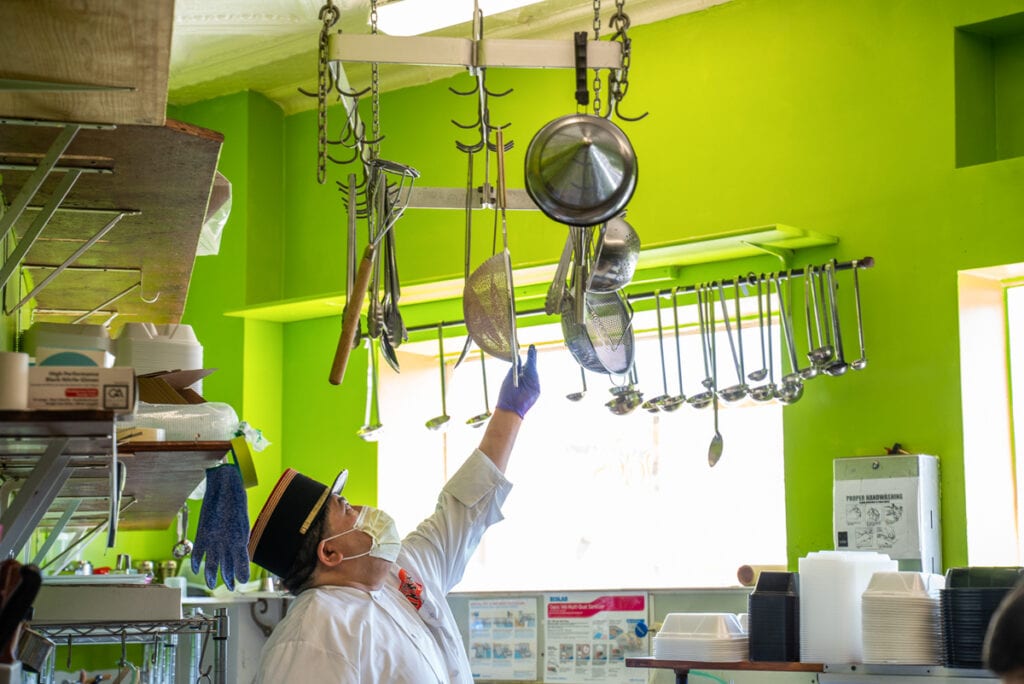
Bahena abandonó el hospital el 24 de noviembre. Cualquier esfuerzo físico le superaba y dirigir la cocina de un restaurante parecía casi imposible. Se sentía frustrado por sus síntomas. Incluso su corto trayecto al trabajo, bajando un tramo de escaleras y luego un corto paseo hasta la puerta del restaurante, era un reto.
Pero sin nadie más al frente de la cocina, sintió que tenía que volver, trabajando menos días a la semana y menos horas al día. Todos menos cinco de los siete trabajadores originales de la cocina se habían marchado o habían sido despedidos, y los que quedaban no podían trabajar a jornada completa. Cuando el único cocinero que quedaba dejó el negocio para abrir una tienda de zumos, el restaurante redujo su horario a la hora de cenar los viernes y fines de semana.
Podrumedzic ha luchado por contratar a suficientes trabajadores para reabrir el restaurante durante la semana.
"No es que vengan a pedirnos que les paguemos $15 o $20 la hora. Es que no vienen". dijo Podrumedzic.
"Obviamente, no somos Lettuce Entertain You, donde podemos poner a una persona sólo para [la parrilla], otra para la ensalada", dijo Podrumedzic. "Somos un pequeño restaurante familiar de inmigrantes, y ofrecemos la mejor comida [que] existe. Por eso tenemos cinco estrellas en Yelp y Google".
Pero Podrumedzic dice que la buena comida y una buena historia no han bastado para salvar el negocio y atraer a nuevos empleados. En todo el país, los restaurantes se enfrentan a la escasez de trabajadores, en parte porque los restaurantes y sus cocinas son Puntos calientes de COVID-19. Los investigadores que analizaron las tasas de morbilidad en California, por ejemplo, descubrieron que las muertes entre los cocineros de línea aumentó en 60% durante la pandemia. Aunque la pandemia está remitiendo en gran parte de Estados Unidos y cada vez más personas se vacunan, muchos restaurantes siguen teniendo dificultades para encontrar trabajadores.
"La verdad es que no lo sabemos"
En abril, Podrumedzic dio al restaurante seis semanas para seguir abierto a menos que el negocio mejorara. En mayo, a medida que el tiempo mejoraba y más habitantes de Chicago recibían la vacuna COVID-19, la situación había mejorado ligeramente.
"Estamos muy ocupados viernes, sábado y domingo", dijo Bahena. "Pero no tenemos ayuda. Tenemos los carteles y tengo que poner otro anuncio para un lavavajillas".
Sin los empleados que tanto necesita, Mis Moles no puede recuperarse de la pandemia. Sus propietarios quieren abrir para el brunch de fin de semana, pero no pueden hacerlo con su actual equipo de cinco personas.
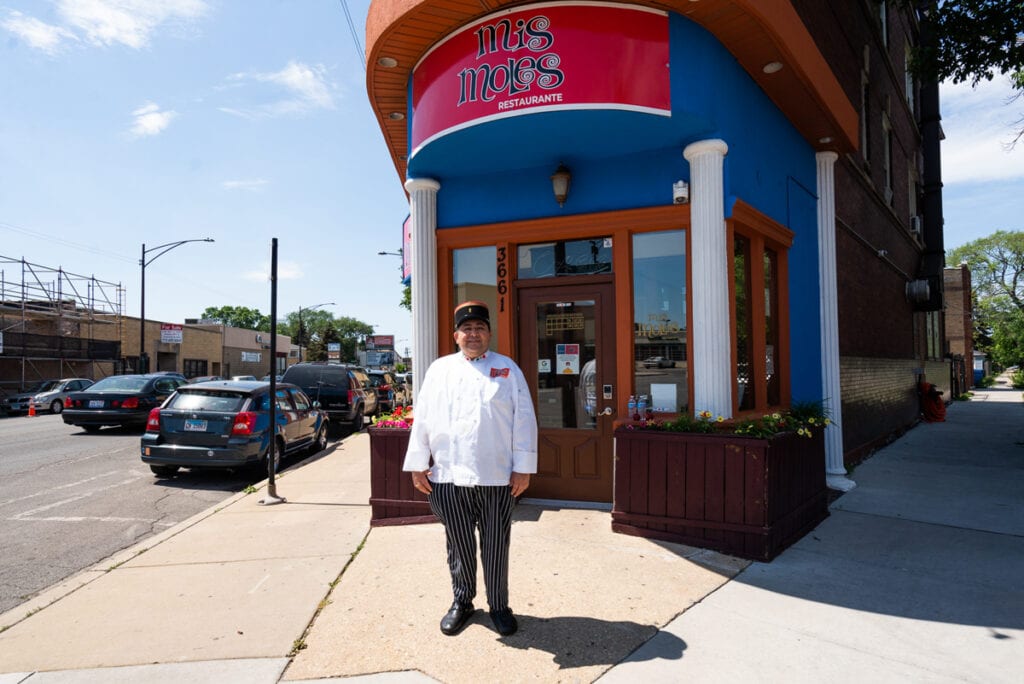
Bahena sigue teniendo síntomas de COVID-19 y no puede trabajar más que unos pocos días a la semana. Ha contratado a un médico para que vigile su salud. "Cuando le digo que estoy enfermo, me dice que debería dar gracias a Dios por estar vivo", afirma.
Mientras tanto, hace lo que puede para salir adelante, yendo a trabajar los viernes, sábados y domingos. Su madre también ayuda, pero a sus 73 años ya no tiene energía para trabajar turnos completos ni todos los días.
Bahena quiere que el restaurante continúe, pero se enfrenta a un futuro incierto. "La verdad es que no lo sabemos", dijo.
Si el negocio no funciona, el plan B de Bahena es abrir otro elegante restaurante mexicano. No se siente cómodo dando detalles sobre este posible próximo paso, pues teme que alguien pueda robarle el menú y el nombre del restaurante.
Lo que sí dijo es que el potencial restaurante se centraría y llevaría el nombre del platillo que aprendió a cocinar en su juventud en Tepatulco, que preparó para dos presidentes norteamericanos y que sirvió a innumerables personas de todo el mundo: el mole.
Este reportaje se realizó en el marco del Metro Media Lab, un proyecto de la Medill School de la Northwestern University destinado a reforzar el periodismo en Chicago. Está financiado por la Fundación Robert R. McCormick.
